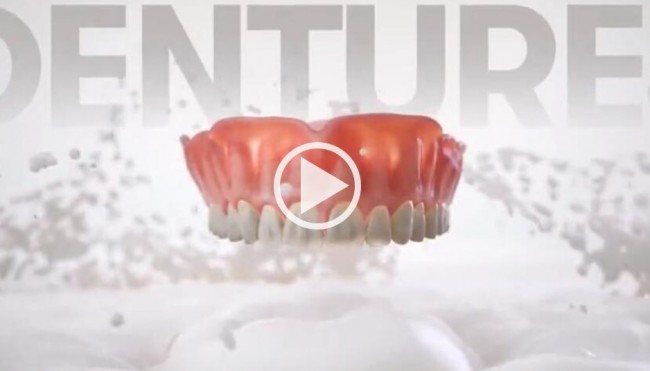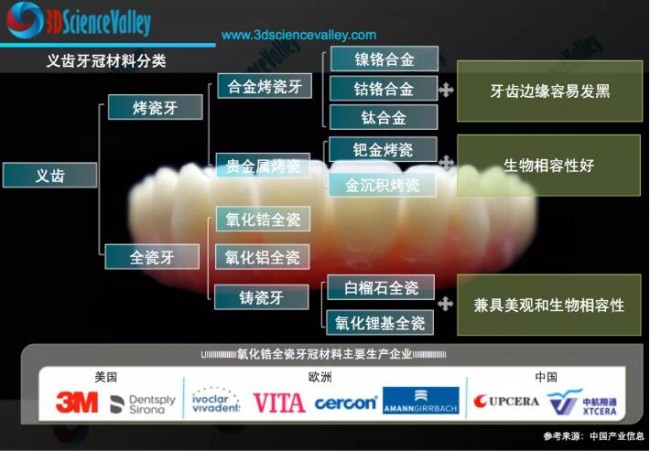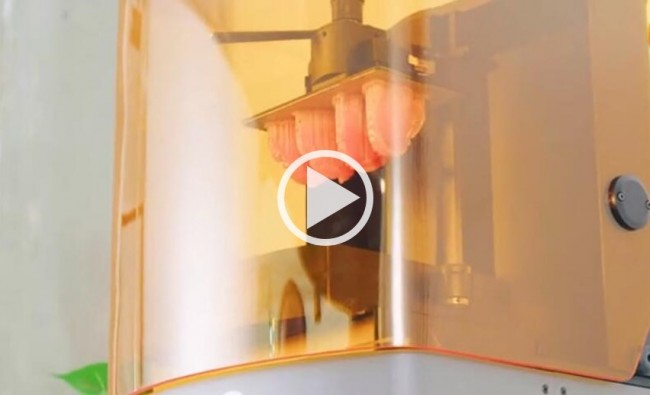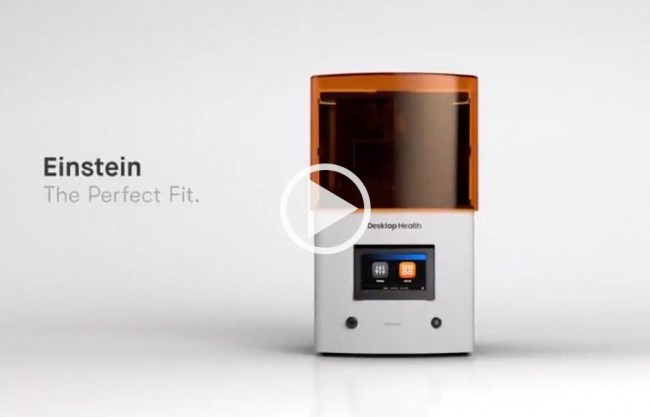Among all kinds of denture restoration materials, all-ceramic teeth have both aesthetics and biocompatibility, and it is expected that the clinical penetration rate will continue to increase in the future. Currently, denture all-ceramic materials with more clinical applications include zirconia-based all-ceramic, alumina-based all-ceramic, leucite all-ceramic, and lithium oxide-based all-ceramic. According to estimates by Dongxing Securities, the market size of all-ceramic teeth for dental implants in China exceeds 2 billion yuan, and the potential market space in the future is about 20 billion yuan.
along with3D printingWith the development of technology, Desktop Health, a subsidiary of Desktop Metal, has launched the Einstein series of high-precision 3D printers designed for dental professionals, and Flexcera Smile Ultra+, the strongest dental ceramic resin approved for permanent use by the FDA.
 © Desktop Health
© Desktop Health
Rapidly iterative dental technology
According to 3D Science Valley, in the current CAM milling of all-ceramic crowns (such as zirconia), the ceramic parts are processed from prefabricated blanks in a pre-sintered state. Due to the low inherent strength of ceramics, thin borders in milling may be Fractures occur, leading to noticeable differences between the designed and manufactured parts. For this reason, thin bezels and edges often require excessive contouring in these areas to prevent edge breakage during machining. However, this also results in a lot of post-processing work in these areas.ceramics3D printingThe technology offers new degrees of design freedom for crown restorations while promising to overcome the technical limitations of standard ceramic crown processing.
 © 3D Science Valley White Paper
© 3D Science Valley White Paper
![]() Long-term stability of 3D printed ceramic dental restorations
Long-term stability of 3D printed ceramic dental restorations
As Smile-Smile, as the name implies in the name of Desktop Metal’s ceramic resin Flexcera Smile Ultra+, ceramic material is recommended as the material of choice due to its excellent biocompatibility, from dental restorations, implants to bone grafts Material. Unlike metals, ceramic materials do not suffer from ion release or corrosion issues, and have long-term stability in both soft and hard tissues. In addition, ceramic materials have also shown significant advantages when making restorations, allowing restorations to look as natural as possible in the long term. From an aesthetic point of view, all-ceramic restorations have a distinct advantage over metal in optically mimicking natural teeth; in the case of gingival recession, there are no grey shades in the gingival area and implants.
 © Desktop Health
© Desktop Health
Desktop Health introduces the Einstein series, a line of high-precision 3D printers it says are designed for dental professionals, and Flexcera Smile Ultra+, which it says is one of the strongest dental resins ever FDA-approved for permanent use. With this combination of 3D printers and materials, dental professionals can use the desired combination to provide individual patients with accurate 3D printed dental restorations for permanent and temporary dental restorations in a variety of applications.
 © Desktop Health
© Desktop Health
It is reported that the combination of advanced resin science and 3D printing technology can provide superior strength, aesthetics and durability. With the combination of Einstein printers and Flexcera Smile Ultra+ resin, dentists can now print veneers, bridges, crowns, dentures, inlays, onlays and more in minutes. This enables the use of aesthetic, functional, same-day dental restorations with ceramic strength – with the added benefit of reducing patient wait times from weeks to hours.
Utilizing digital light processing (DLP) technology, Einstein printers are engineered with proprietary NanoFit 385 technology to ensure an accurate fit and natural-looking appearance with stunning clarity every application. Equipped with Hyperprint technology to take advantage of heat and closed-loop software upgrades, Einstein printers now offer superior accuracy and are 50 percent faster than their predecessors.
The Einstein family is available in a variety of 3D printing solutions to meet specific customer needs, from clinicians to laboratories. Combining Einstein printers with proprietary resin science and technology, the Einstein family includes Einstein, designed for general dentists to enable chairside printing; Einstein Pro, designed for small dental labs and specialists; and Einstein for high-volume dental labs The studio-designed Einstein Pro XL offers the largest build range in the series.
The original Flexcera Smile Ultra+, first introduced in 2020 for temporary dental applications, is an FDA 510(k) cleared Class 2 medical device for permanent, printable dental restorations. It is formulated with ceramic long-chain chemistry to ensure ideal performance. When paired with Einstein 3D printers, dental providers can now print crowns, bridges, veneers, full and partial dentures the same day.
Newer Flexcera resins provide high fracture resistance in dental restorations, up to three times the fracture resistance of ceramic restorations made with typical resins; and moisture resistance to prevent staining or discoloration; resistance to fracture and staining and discoloration The combination of 3D printed ceramic restorations enhances the overall natural aesthetics of 3D printed ceramic restorations, providing patients with realistic tooth translucency for a combination of comfort, strength and flexibility.
![]() The technical logic of 3D printing ceramic dental restorations
The technical logic of 3D printing ceramic dental restorations
Often referred to as “ceramic steel”, zirconia is commonly used in restorative dentistry to restore missing teeth or dental material, through teeth to support crowns, fixed dental prostheses (FDP) and defective restorations (such as occlusal veneers) to repair. Zirconia can also replace missing teeth with dental implants and implant-supported restorations.
The CAM (Computer Aided Manufacturing) program for machining zirconia is processed by subtractive techniques, that is, the zirconia parts mentioned above are processed from prefabricated zirconia blanks in a pre-sintered state, the so-called white body state. become. In this state, the inherent strength of zirconia is low. Due to this fact, thin bezels can break during subtractive machining, leading to noticeable differences between the designed and manufactured parts.
For this reason, thin bezels and edges often have to be over-profiled in these areas to prevent edge breakage during machining, according to TCT Asia Perspective. However, this also results in a lot of post-processing work in these areas. Since crown margins and occlusal surfaces are a very important area of crown and bridge restorations, post-processing must be performed under a stereomicroscope, which is rather time-consuming and cost-intensive. In addition, occlusal fissures also require post-processing, since rotary instruments can only reproduce the classic conical fissure geometry to a limited extent.
With ever-increasing demands for aesthetics and performance, ceramic 3D printing emerged as a solution to meet the challenges of the dental field. It offers new degrees of design freedom, enabling complex 3D metal-free applications to be produced layer-by-layer while overcoming the technical limitations of standard ceramic processes.
![]() Commercialization of ceramic 3D printed dentures
Commercialization of ceramic 3D printed dentures
In the commercial development of ceramic 3D printed denture applications, according to the market observation of 3D Science Valley, the commercialization of European established dental companies is one step faster. In 2020, Bego and Straumann, two well-known dental companies, have made new trends in the field of ceramic 3D printed dentures. Bego has launched a ceramic composite for photocurable 3D printing, which can be used to make permanent single crowns, inlays, onlays, veneers. Bego has disclosed the results of a long-term stability study of 3D printed ceramic crowns fabricated from this material. Well-known dental company Straumann Group is an early adopter of ceramic additive manufacturing technology, which Straumann has used for new product iterations and proof-of-concept.A few days ago, the two sides announced that they will cooperate to promote ceramic nanojets3D printing technologyApplications in the production of dental final products.
(responsible editor: admin)



0 Comments for “FDA Approves Dental Resin For Permanent Use, See How Desktop Health’s New 3D Printing Technology Impacts All-Ceramic Dental Market”